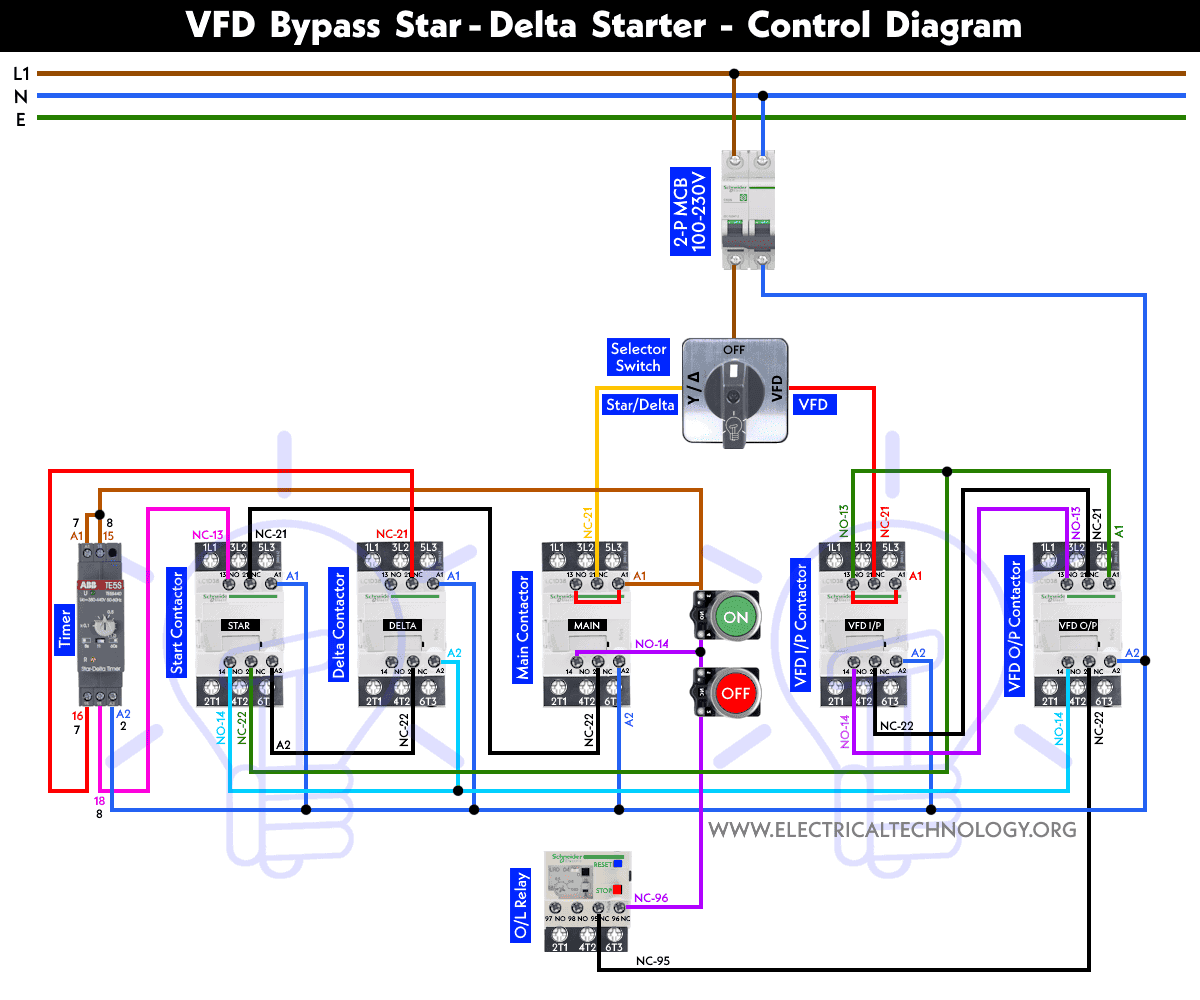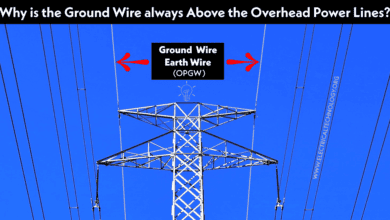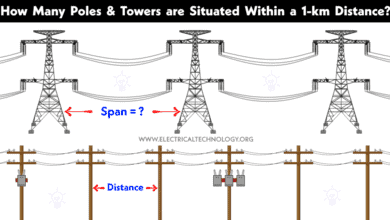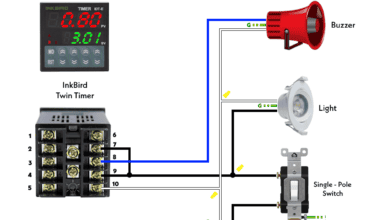How to Bypass a VFD and Run a Three-Phase Motor Using Star-Delta Starter?
Variable Frequency Drives (VFDs) have revolutionized industrial applications by enabling precise control over motor speed and improving energy efficiency. However, there are scenarios where VFDs might need to be bypassed temporarily or permanently. One common approach in such cases is the VFD Bypass Star-Delta Starter. In this article, we will show how to bypass a VFD and run the motor through semiautomatic Star-Delta starter (when needed) with the help of power and control diagrams.
VFD and Δ/Y Starter
Variable Frequency Drive (VFD)
A Variable Frequency Drive (VFD), also known as a Variable Speed Drive, is an electronic device that regulates the speed of an electric motor by varying the frequency and voltage supplied to it. VFDs allow for precise control over motor speed, torque, and acceleration, leading to improved energy efficiency and reduced wear and tear on mechanical components.
Star-Delta Starter
A Star-Delta Starter is a traditional motor starting method that reduces the inrush current during motor startup. It involves connecting the motor windings in a star configuration during startup to limit the starting current, and then switching to a delta configuration for normal running conditions. This method is particularly useful for large motors where high starting currents could lead to network disturbances or motor damage.
The Need for Bypass
While VFDs offer numerous benefits, they can also introduce complexities and vulnerabilities. In some situations, it might be necessary to bypass the VFD temporarily or permanently. This need could arise due to VFD maintenance, failure, or a desire to run the motor using traditional control methods. The VFD Bypass Star-Delta Starter provides a solution by allowing the motor to operate in both VFD-controlled and bypass modes.
Components Needed
- Three-Phase Motor
- 5 Nos. of Contactor
- Variable Frequency Drive (VFD)
- Thermal Overload Relay
- Timer (TE5S Star-Delta Timer)
- 3-P MCCB
- 2-P MCB
- Selector Switch for VFD, Δ/Y & Manual ON/OFF Control
- External Start and Stop pushbuttons
- Single-Phase & Three Phase Supply
- Wires & Cables
Wiring of Bypassing VFD For Star/Delta Starter
Power Diagram:
Connect the Star Delta Starter (Main, Star, and Delta Contactors) as well as the VFD using VFD INPUT and OUTPUT contactors to the overload relay and motor. This connection should be established from the three-phase power supply via a 3-pole MCCB, as shown in the power diagram.
Click image to enlarge
Control Diagram:
- Connect the Main, Star and Delta Contactors from the 2-poles MCB via the selector switch. Wire the Δ/Y timer to the Y and Δ contactors accordingly.
- Connect the VFD I/P and VFD O/P contactors as a parallel power supply as shown in the control circuit diagram.
- Connect the overall output 3-phase wires from both STAR/DELTA and VFD to the O/L relay and then the motor terminals (U1,V1 & W1 to the W2, U2 and V2).
Click image to enlarge
Working Principle of VFD Bypass Star-Delta Starter
The VFD Bypass Star-Delta Starter integrates the capabilities of both the VFD and the Star-Delta Starter. Here’s a step-by-step breakdown of how it works:
VFD Control (Auto) Mode:
-
- When the operator rotates the selector switch to the “VFD” mode, the motor starts and is controlled by the VFD.
- In this mode, the VFD regulates the motor’s speed and other parameters based on the desired application requirements.
- The VFD takes in control signals and processes them to adjust the frequency and voltage supplied to the motor.
- The motor operates with the advantages of precise speed control and energy savings.
Bypass Mode (Δ/Y = Semiautomatic):
-
- When the VFD needs to be bypassed, such as during maintenance or in case of VFD failure, the system switches to bypass mode by rotating the selector switch to the Δ/Y Mode.
- The motor is disconnected from the VFD output and connected to the Star-Delta Starter.
- The Star-Delta Starter employs the star-delta motor starting method, limiting the starting current and gradually transitioning the motor to full speed.
- The manual ON and OFF pushbuttons can be used to Start and Stop the Motor when needed.
Transition Logic:
-
- A control system monitors the status of the VFD and the bypass mode requirement.
- When a bypass is initiated, the control system ensures a smooth transition from VFD control to the Star-Delta Starter.
- Once the bypass mode is no longer required, the control system facilitates a seamless return to VFD control.
Advantages of VFD Bypass Star-Delta Starter
- Flexibility: The system offers the flexibility to operate the motor in VFD-controlled mode for energy-efficient operations and in bypass mode when necessary.
- Inrush Current Limitation: The Star-Delta Starter’s inrush current limitation helps prevent network disturbances during motor startup.
- VFD Maintenance: Bypassing the VFD during maintenance reduces downtime, as the motor can continue operating using the traditional starter.
- Reliability: If the VFD experiences a failure, the bypass mode ensures the motor can still run, maintaining productivity.
- Cost Savings: While VFDs can be expensive, the bypass mode utilizes existing motor control infrastructure, reducing the need for additional investments.
Applications
The VFD Bypass Star-Delta Starter finds application in various industrial scenarios:
- Critical Processes: Industries with critical processes can’t afford extended downtimes. The system ensures uninterrupted motor operation during VFD maintenance or repairs.
- Large Motors: Motors with high power ratings benefit from reduced starting currents provided by the Star-Delta Starter, enhancing motor life and network stability.
- Mixed Operations: Some processes may require both variable speed control and fixed speed operation. The system accommodates such requirements efficiently.
- Energy Management: In situations where energy efficiency is a priority, the VFD can be used for regular operation, while bypass mode is engaged only when necessary.
Related Posts:
- How to Wire a VFD with Motor, PLC, Switches & External Devices
- How to Run a Three-Phase Motor on Single-Phase Supply Using VFD?
- How to Reverse and Forward a Three-Phase Motor Using a VFD?
- Automatic & Manual Control of Motor Using VFD & DOL Starter
- VFD Bypass DOL Starter – Power, Wiring and Control Circuits
- Star & Delta Motor Control Circuit Using Omron PLC ZEN Programming Relay
- Star & Delta Starter Using Different PLCs – Wiring and Ladder Diagram
- Star & Delta Motor Control Circuit Using Delta – DVP 14SS2 Series PLC
- Star & Delta Motor Control Using Schneider Zelio Logic PLC Smart Relay
- Automatic Star & Delta Starter Motor Control Circuit Using LOGO! V8 PLC
- Star & Delta Starter Motor Control Circuit Using S7-1200 PLC
- Star-Delta Starter for Reverse & Forward Operation Without Timer
- STAR-DELTA Starter Motor Starting Method Without Timer
- Reverse-Forward Star/Delta Starter for Three Phase Motor using Timer
- Automatic Star-Delta Starter using Timer – Power, Control & Wiring Diagrams


 What is Sag in Overhead Power Transmission Lines?
What is Sag in Overhead Power Transmission Lines? Why is the Ground Wire Always Positioned Above the Overhead Power Lines?
Why is the Ground Wire Always Positioned Above the Overhead Power Lines? How Many Poles and Towers are Situated Within a 1-km Span?
How Many Poles and Towers are Situated Within a 1-km Span? Why are Overhead Power Transmission Lines Not Insulated?
Why are Overhead Power Transmission Lines Not Insulated? How to Wire Twin Timer for Repeated ON-Delay in Cycle Mode?
How to Wire Twin Timer for Repeated ON-Delay in Cycle Mode? Wire Twin Timer in Repeat Cycle & One-Shot Mode for 120V/240V Motors?
Wire Twin Timer in Repeat Cycle & One-Shot Mode for 120V/240V Motors?